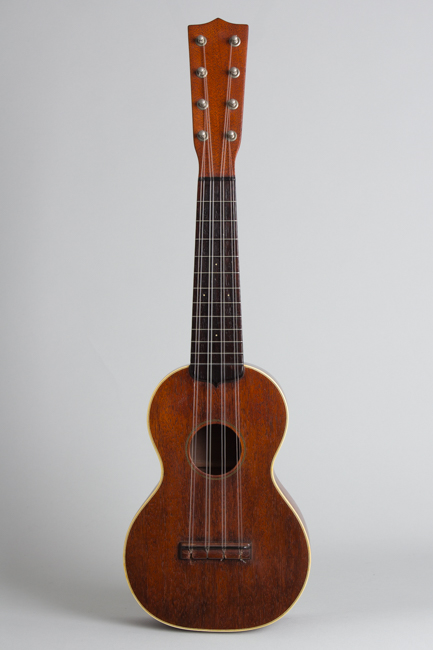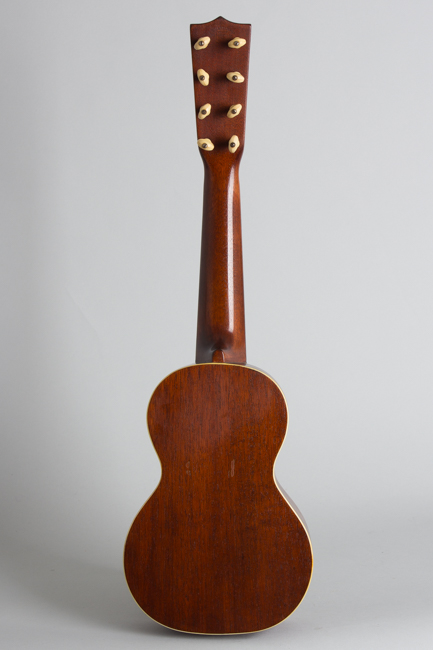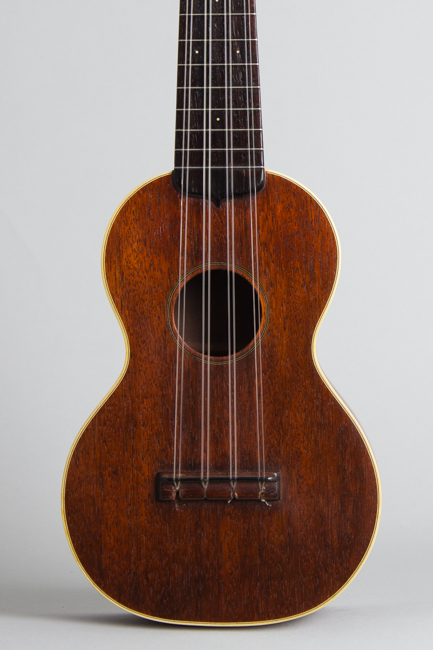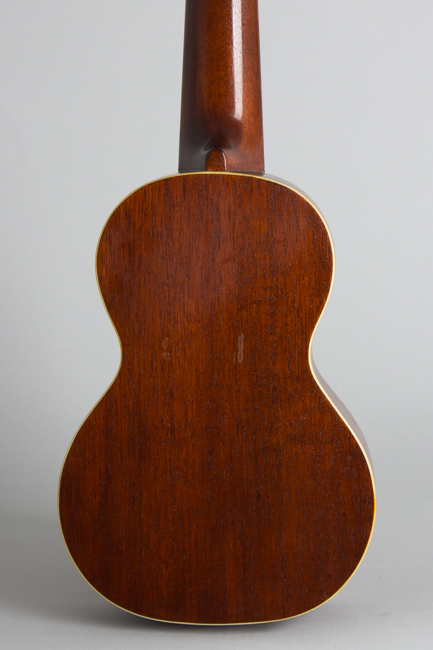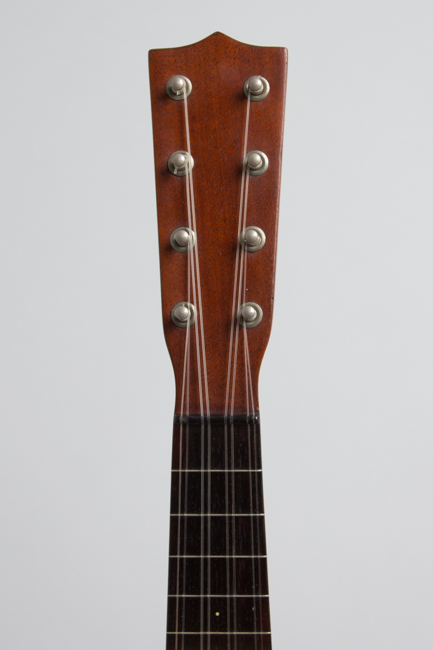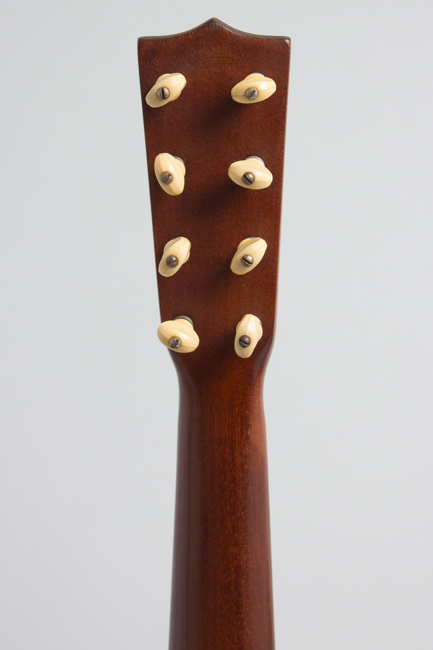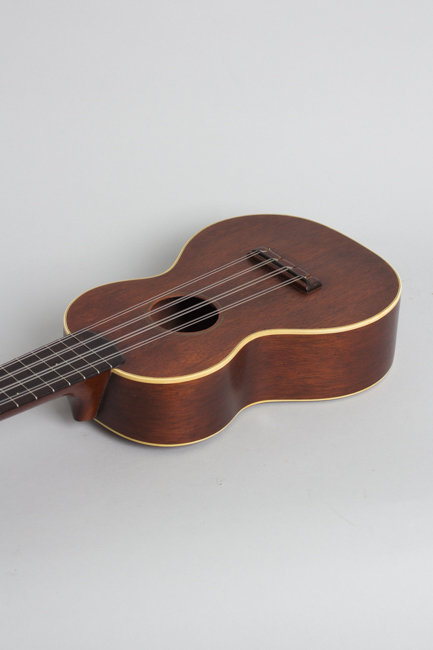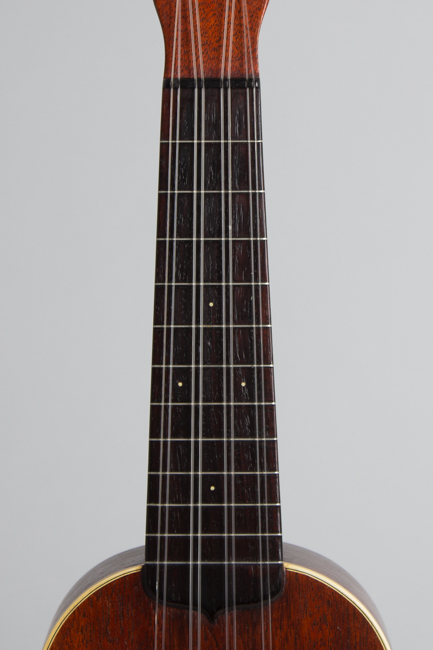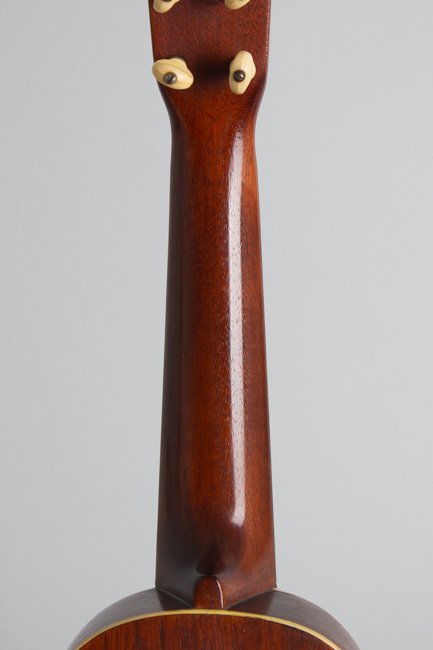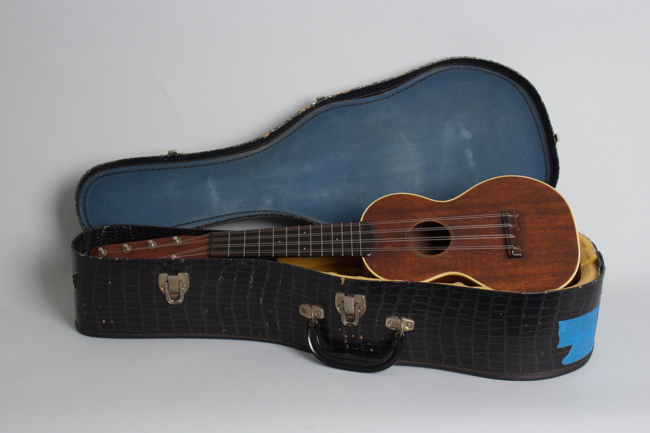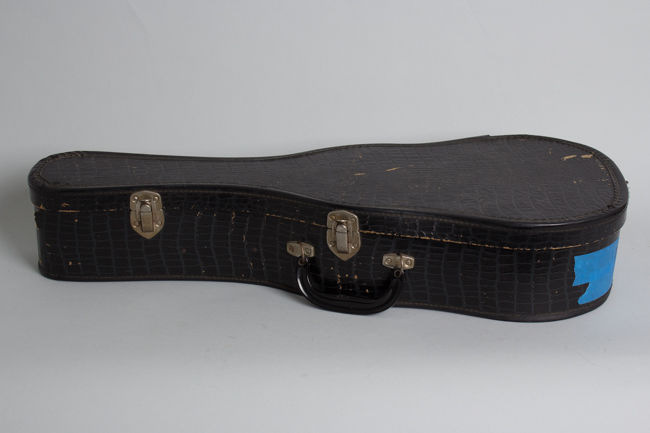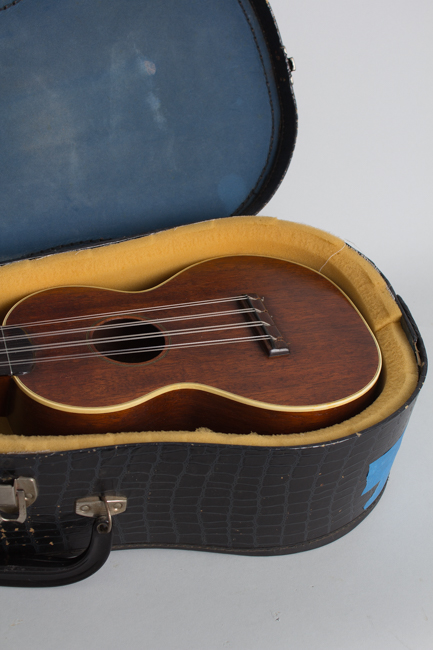C. F. Martin Style 2M Taropatch (1927)
C. F. Martin Style 2M Model Taropatch (1927), made in Nazareth, PA, dark mahogany finish, mahogany body and neck, rosewood fingerboard, black chipboard case.
The eight-string Taropatch (originally called the "Taro Patch fiddle") was one of the early Hawaiian forms of the ukulele, persisting in the islands even after the familiar 4-string uke was popularized. Comparatively few versions were ever made on the mainland, but the instrument was offered as part of C. F. Martin's early ukulele line from 1916 through 1931. With eight gut strings on a longer scale neck the taropatch was considered harder to play (and tune!) than the simple uke, and thus ordered in vastly smaller numbers. Eventually Martin adapted this body form into the 4-string concert uke, which pretty much replaced it in the company's line.
The Martin Taropatch was offered as a stock model in styles 1,2 and 3; this later 1920s Style 2 is a very rare instrument. 1927 was the last year the Style 2 Taropatch was produced, but also the year these barrel-shaped Grover Simplex tuners were introduced making dating this one more precise than most! This would be one of only 20 examples shipped that final year, out of a grand total of 387 made since 1916. Style 2 Taropatches were listed in the catalog until 1931 but no more were actually built.
Style 2 was Martin's midline level for uke family instruments; pro-quality, more decorated than the simple Style 1 but not as out-and-out flashy as the Style 3. This Taropatch sports a very thin dark natural mahogany finish offset with 3-ply white celluloid binding around the top and a single ply on the back. There is a discreet wooden sound hole ring ornament and 4 tiny position dots on the fingerboard, a feature added in 1918. The nut and saddle are ebony. As noted the tuners are white-button Grover Simplex friction pegs, a new feature for 1927 thus rarely seen on this then rapidly fading model. This is a lovely rare find and a fine playing instrument; while more awkward to tune than a 4-string uke it rewards the player with a distinctive chorused double-strung sound that has a real archaic island character.
Overall length is 25 1/8 in. (63.8 cm.), 7 5/8 in. (19.4 cm.) wide at lower bout, and 2 3/4 in. (7 cm.) in depth at side, taken at the end block. Scale length is 14 3/4 in. (375 mm.). Width of nut is 1 1/2 in. (38 mm.).
This nearly century old Taropatch survives in overall original and very good playing condition. The very thin varnish finish has some general wear with dings, dents and strumming marks but two chips to the back are the only notable loss. As with many Taropatches the recesses in the bridge holding the doubled strings show some wear and re-working, mostly notable on the slot for the top pair. The nut has a chip between these two strings as well but the slots themselves are not compromised. The instrument plays nicely and holds tune as well as these ever do, a nice example of a rare and beautiful early Martin ukulele family instrument that seldom turns up today. It resides in a later (1950s) chipboard case, lined out with old foam for a better fit. Very Good + Condition.
The eight-string Taropatch (originally called the "Taro Patch fiddle") was one of the early Hawaiian forms of the ukulele, persisting in the islands even after the familiar 4-string uke was popularized. Comparatively few versions were ever made on the mainland, but the instrument was offered as part of C. F. Martin's early ukulele line from 1916 through 1931. With eight gut strings on a longer scale neck the taropatch was considered harder to play (and tune!) than the simple uke, and thus ordered in vastly smaller numbers. Eventually Martin adapted this body form into the 4-string concert uke, which pretty much replaced it in the company's line.
The Martin Taropatch was offered as a stock model in styles 1,2 and 3; this later 1920s Style 2 is a very rare instrument. 1927 was the last year the Style 2 Taropatch was produced, but also the year these barrel-shaped Grover Simplex tuners were introduced making dating this one more precise than most! This would be one of only 20 examples shipped that final year, out of a grand total of 387 made since 1916. Style 2 Taropatches were listed in the catalog until 1931 but no more were actually built.
Style 2 was Martin's midline level for uke family instruments; pro-quality, more decorated than the simple Style 1 but not as out-and-out flashy as the Style 3. This Taropatch sports a very thin dark natural mahogany finish offset with 3-ply white celluloid binding around the top and a single ply on the back. There is a discreet wooden sound hole ring ornament and 4 tiny position dots on the fingerboard, a feature added in 1918. The nut and saddle are ebony. As noted the tuners are white-button Grover Simplex friction pegs, a new feature for 1927 thus rarely seen on this then rapidly fading model. This is a lovely rare find and a fine playing instrument; while more awkward to tune than a 4-string uke it rewards the player with a distinctive chorused double-strung sound that has a real archaic island character.
Overall length is 25 1/8 in. (63.8 cm.), 7 5/8 in. (19.4 cm.) wide at lower bout, and 2 3/4 in. (7 cm.) in depth at side, taken at the end block. Scale length is 14 3/4 in. (375 mm.). Width of nut is 1 1/2 in. (38 mm.).
This nearly century old Taropatch survives in overall original and very good playing condition. The very thin varnish finish has some general wear with dings, dents and strumming marks but two chips to the back are the only notable loss. As with many Taropatches the recesses in the bridge holding the doubled strings show some wear and re-working, mostly notable on the slot for the top pair. The nut has a chip between these two strings as well but the slots themselves are not compromised. The instrument plays nicely and holds tune as well as these ever do, a nice example of a rare and beautiful early Martin ukulele family instrument that seldom turns up today. It resides in a later (1950s) chipboard case, lined out with old foam for a better fit. Very Good + Condition.
